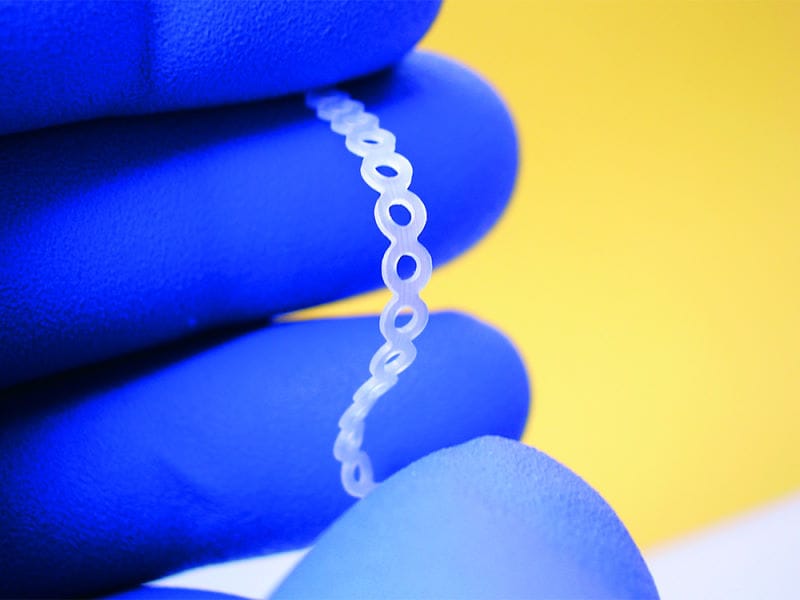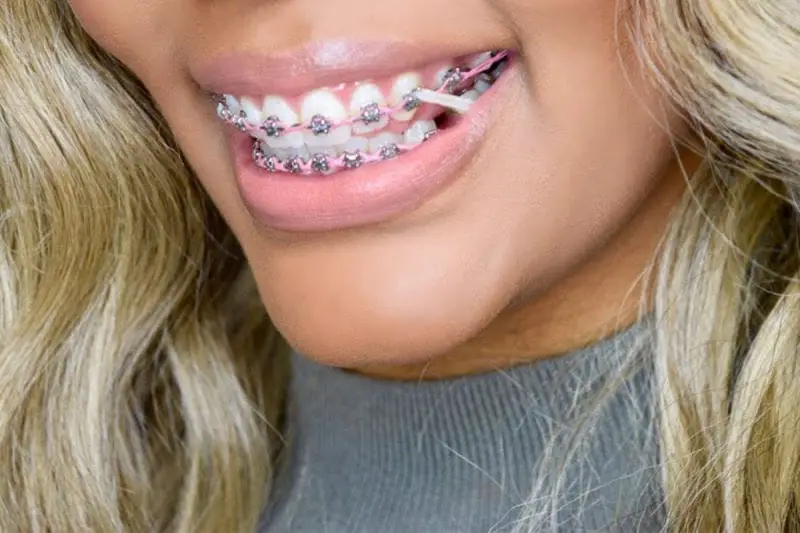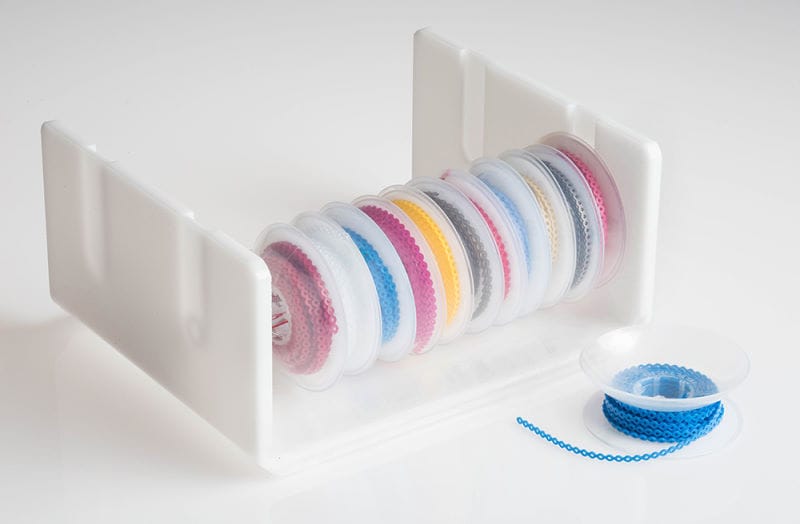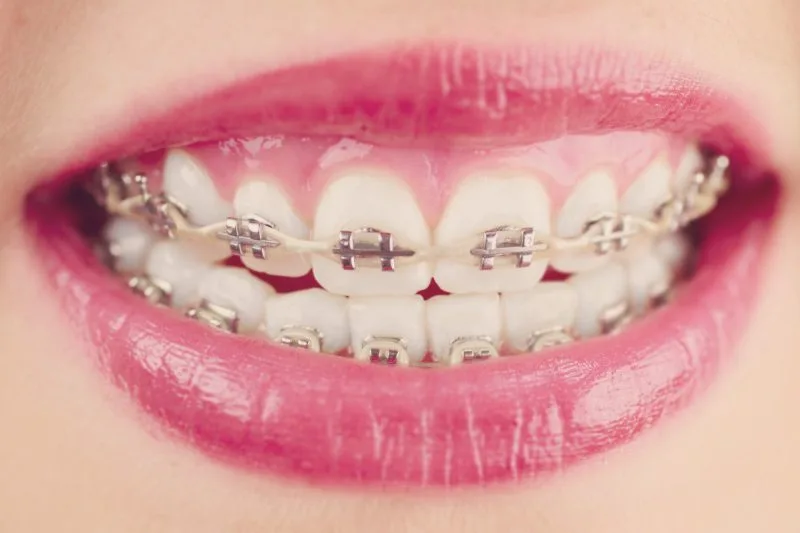If you’ve been wearing braces for a while, you’ve probably found out the treatment involves more than just brackets and a wire. Getting power chains fitted can be a bit of a step up in terms of pain, but it’ll be worth it as you see those gaps closing!
Are Power Chains The Last Step In Braces?
Getting power chains is often one of the last steps in your braces journey. However, it’s not always an indicator that your treatment is over. You can actually get fitted with power chains at a few key stages of braces treatment.
If you’ve just been given a power chain and you’re getting excited about your braces finally coming off – check with your dentist about the treatment time remaining. They are the professionals and know where you are in the plan. So what are they for then?

What Do Power Chains Do On Braces?
Power chains are used to pull teeth towards each other – primarily to close gaps. The tension of the stretched rubber pulls the teeth together as the chain wants to go back to its original shape. Power chains stretch a surprising amount but are still strong enough to do a lot of work fast.
The main uses of power chains are to:-
- Close gaps in teeth – Natural gaps and one created by extractions
- Close gaps again after space was made for tooth movement
- Rotating teeth – Especially in canines.
- Keep a row of teeth together while there is more alignment to be completed
The most common use of power chains is to close gaps between teeth, especially when teeth are mostly aligned already. So when your teeth have been pulled backward or forward enough and the braces wire is in a fairly straight line, the power chains just close up any spacing left.
They’re used a lot when teeth have been removed. Premolars are often taken out on the top row – and sometimes lower – when the jaw is crowded. Sometimes space is created to move other teeth into their correct position, then power chains close that gap up again.
Power chains can also be useful when rotating the canines (or other teeth occasionally because they are quite deep-rooted teeth. Sometimes a button is added to the back of a tooth to attach the power chain.
Finally, power chains are used to stop gaps from opening up again after a lot of treatment has been done. In the last 3-6 months when the final alignment is happening to perfect the smile, gaps can open up. Power chains help to stop this happening.
Why Isn’t Every Power Chain Hole Attached?
Sometimes the power chain will be attached to almost all of one row, sometimes just a couple of links will be used to pull two teeth together, sometimes four. You might have two small sets on either side of your mouth – I’ve had all of these at different times in my treatment.
It’s also common to have a full row of power chains with a couple of links purposely not attached. If you have just had power chains in and are worried your orthodontist has forgotten something – don’t panic. Shoot them an email or call to double-check if you want but it’s most likely on purpose.
Do You Get Power Chains And Elastics?
Normally the power chain comes on its own and you don’t need the normal little elastics to hold the wire to the bracket. Sometimes your orthodontist will use both. They might also tie a wire around a set of teeth to stop them from moving apart.
What Are Power Chains?
Power chains are essentially an elastic rubber chain. The elastics use to hold brackets to braces and power chains are both technically called ligatures. Power chains come in a roll that dentists can cut to size for the specific length and amount of holes they will use.
They’re very thin – normally around .020″ thick – and can be made of latex or a blend of different polymers. They are able to stretch will having a pulling force, and can retain nearly 80-85% of their strength over 6 weeks.
When Do You Get Power Chains?
You can get power chains at lots of different stages in your braces treatment, from early to very late. In general, the starting few months will be about pulling any teeth that are too far forwards, backward, or too far out of alignment back into alignment. So power chains tend to come later on in treatment.
However, you might have a gap to close where there is no alignment issue and could get a short power chain to close that gap. This happens a lot after extractions that happen before your treatment, like the removal of some premolars.
Often your major alignment issues will be solved fairly early on in the first six months. Then you’ll move into rotating the teeth into their final perfect position and close gaps. Power chains really help to finalize the closing of gaps and stop gaps ofrom opening up again.

Does Everyone Get Power Chains With Braces?
Not everyone will get power chains as part of their treatment, especially without gaps or without needing removals. However, more people need power chains that not. You might not have them for your entire treatment and you’ll also get used to them very fast.
Do Power Chains Hurt?
Getting power chains put on can be a little uncomfortable as the orthodontist needs to stretch the bands over the brackets. They also create a force you might not be used to. In general, I’d say after a wire change, having power chains was only a little more painful than after appointments without them.
Really though, it will only take a few days to get used to it – just like after a normal appointment. As usual avoid solid, bitey foods for the first few days as it will be painful to bite. If they’re aching, use our personal guide to stop braces pain immediately.
Types Of Power Chains For Braces
There are different types of power chains with varying strengths and spacing between holes. The main sizes are closed (or continuous), short, and long, or short, middle, and long depending on the manufacturer. Power chains also come in various colors including a clear transparent version.
The reason for having different spacing is that in the short or continuous ones they can connect at every tooth. In the longer ones, you can connect every other tooth. It all depends on the treatment. Some orthodontists use a continuous power chain but just won’t connect some of the middle holes to the brackets.

Double Power Chains
Your dental professional might put double power chains on a row of teeth if they want to close gaps fast. This can help when you have very dense bone or strong teeth that refuse to budge. You might also get one smaller set, then a full chain over the top.
